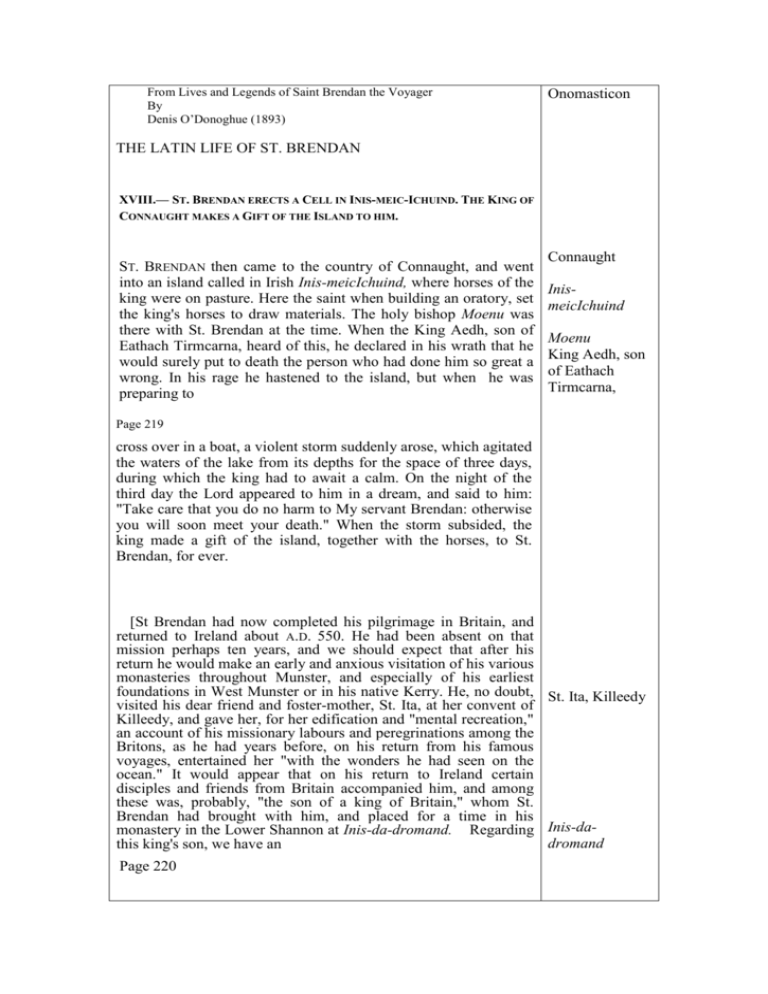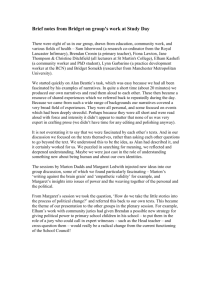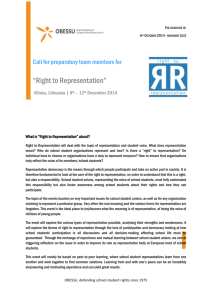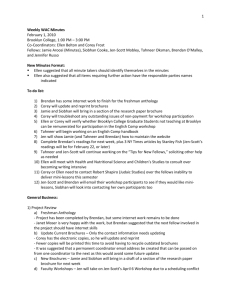From Lives and Legends of Saint Brendan the Voyager
advertisement

From Lives and Legends of Saint Brendan the Voyager By Denis O’Donoghue (1893) Onomasticon THE LATIN LIFE OF ST. BRENDAN XVIII.— ST. BRENDAN ERECTS A CELL IN INIS-MEIC-ICHUIND. THE KING OF CONNAUGHT MAKES A GIFT OF THE ISLAND TO HIM. ST. BRENDAN then came to the country of Connaught, and went into an island called in Irish Inis-meicIchuind, where horses of the king were on pasture. Here the saint when building an oratory, set the king's horses to draw materials. The holy bishop Moenu was there with St. Brendan at the time. When the King Aedh, son of Eathach Tirmcarna, heard of this, he declared in his wrath that he would surely put to death the person who had done him so great a wrong. In his rage he hastened to the island, but when he was preparing to Connaught InismeicIchuind Moenu King Aedh, son of Eathach Tirmcarna, Page 219 cross over in a boat, a violent storm suddenly arose, which agitated the waters of the lake from its depths for the space of three days, during which the king had to await a calm. On the night of the third day the Lord appeared to him in a dream, and said to him: "Take care that you do no harm to My servant Brendan: otherwise you will soon meet your death." When the storm subsided, the king made a gift of the island, together with the horses, to St. Brendan, for ever. [St Brendan had now completed his pilgrimage in Britain, and returned to Ireland about A.D. 550. He had been absent on that mission perhaps ten years, and we should expect that after his return he would make an early and anxious visitation of his various monasteries throughout Munster, and especially of his earliest foundations in West Munster or in his native Kerry. He, no doubt, St. Ita, Killeedy visited his dear friend and foster-mother, St. Ita, at her convent of Killeedy, and gave her, for her edification and "mental recreation," an account of his missionary labours and peregrinations among the Britons, as he had years before, on his return from his famous voyages, entertained her "with the wonders he had seen on the ocean." It would appear that on his return to Ireland certain disciples and friends from Britain accompanied him, and among these was, probably, "the son of a king of Britain," whom St. Brendan had brought with him, and placed for a time in his monastery in the Lower Shannon at Inis-da-dromand. Regarding Inis-dadromand this king's son, we have an Page 220 extraordinary tale in the Life of St. Ruadhan, in the Codex Salmanticensis, as follows:— "On a certain occasion the boat of Brendan was sunk to the bottom of the sea in the Lower Shannon (Mare Luiemnech in the text), and the son of the King of Britain was at the time asleep in the prow of the boat, and went to the bottom with it. Then Brendan told his monks to go at once to St. Ruadhan, for to him had God granted the power to raise their boat from the depths of the sea, and to restore to life the king's son that was drowned in it. They went accordingly to St. Ruadhan, and he came with them at once to the place where the boat had sunk, and when he had offered a prayer the boat instantly rose to the surface with the king's son in it alive and safe; whereupon he told them that St. Ruadhan had placed his cowl around his head, so that he felt not the water." It is not stated whether St. Brendan was present on this occasion; very probably he was not; and when the story reached him at a distance, he directed his monks to call in their saintly neighbour, St. Ruadhan, from Lorrha, on the other side of the Shannon, to perform the needful miracle for his special friend, St. Brendan. Another disciple who accompanied our saint from Britain was "that monk who had come from his parents with him from Britain," of whose death and miraculous restoration to life we will read in a succeeding chapter of this Life, and whose name is stated in the Life of Brendan, from the Codex Salmanticensis, to be Senan, whom St. Brendan restored to life, "because he had promised his parents, when they committed their son to his care, that they would see him again safe and sound." St. Ruadhan Shannon Mare Luiemnech St. Ruadhan Lorrha, Senan Page 221 I cannot help thinking that St. Brendan about this period visited his proto-monastery at Ardfert, and remained there for some time, in loving intercourse with his spiritual children in that religious house, which was his earliest foundation, and in which he, no doubt, retained an affectionate interest amid all his missionary labours and solicitudes. Here he may have sought and taken some needful rest after his many wanderings by land and sea, and having now long passed his sixtieth year, it would be natural enough that he should say: "Here, among my first-born spiritual children, is my rest for ever and ever; here will I dwell, for I have chosen it." But this was not his choice, for he knew for many years that "the place of his resurrection" should be elsewhere. Hence he soon after turned his face once more to "the country of Connaught;" and for this new missionary toil he had, I believe, a special reason and attraction. For some time before this period a remarkable migration of St. Brendan's countrymen, the Ciarraidhe, was in progress from the plains of their native Kerry to the wide and beautiful plains of Roscommon and Mayo, in Connaught. This migration commenced early in the reign of Aedh, son of Eochaidh Tirmcharna, probably before A.D. 550, under the conduct of a Kerry prince, Cairbre MacConuire, who, because of some intestine broils, of which neither history nor tradition tells, was driven into forced exile, with large numbers of his clan. John O'Donovan (Book of Rights Page 100, n.f.) gives an account of this migration from an ancient Gaelic MS. in the library of Trinity College, Dublin, which is very interesting :— "When first did the Ciarriadhe come into Connaught'? Not Ardfert Connaught Ciarraidhe Roscommon and Mayo Aedh, son of Eochaidh Tirmcharna Cairbre MacConuire, Ciarriadhe difficult. In the time of Aedh, son of Eochaidh Page 222 Tirmcharna. Which of them came in first? Not difficult. Coirbri MacConuire, who came from the south of Munster, whence he had been expelled. He came with all his people to Aedh, son of Eochaidh Tirmcharna. Coirbri had a daughter famed for her beauty and accomplishments, and Aedh asked her of her father in marriage. After the marriage she came one time to visit her father, who showed great grief in her presence. She asked him whence his grief arose. "My being landless in exile," said he. Messengers came from the king for his wife, but she would not go to him until he should give a good tract of land to her father. "I will give him," said Aedh, "as much of the wooded lands to the west as he can pass round in one day, and St. Caeilin, the pious, shall be given as a guarantee for' it." The tale goes on to say that Cairbre had made a wide circuit in his day's journey, to the great jealousy and vexation of King Aedh's subjects, who conspired to poison Cairbre in a draught of beer; but this was revealed to St. Caeilin, who indignantly demanded why the king had violated her guarantee by conniving at this intended murder. "I will violate thee," said she to Aedh, "as regards thy kingdom." The king submitted to her award of punishment for his share in the conspiracy, which was a singular one. "Because you sought to destroy Cairbre, in a drink of beer, may the King of Connaught meet decline or certain death, if ever he drink of the beer of the Ciarraidhi,"* He then gave the saint the land on which her church of Aedh, son of Eochaidh Tirmcharna Coirbri MacConuire, St. Caeilin Ciarraidh * It would seem from this that the beer of the Ciarraiilhe was remarkably good; whereas, in the judgment of this saint, the privation of it was condign penance for the crime of a king. Ancient Kerry was famous also for its mede or metheglin, for O'Heerin sings of the King of Kerry, as The chief of the mede-abounding land From Tralee to the fair-streamed Shannon. Page 223 Termon Mor or Termon Caeilinne was afterwards built. The migration thus commenced continued for many years, so that three extensive colonies of the Ciarraidhe were settled in large districts of Roscommon and Mayo, respectively called the Ciarraidhe-Aei, the Ciarraidhe Locha na n-Airneadh, and the Ciarraihde Airtich. These emigrants mostly belonged to one of the principal branches of the Ciarraidhe to which the sept of Altraighe, St: Brendan's own sept, gave its kinglets or chiefs, as O'Heerin tells us :— All the Altraighe return Two kings of the Plain of Ciarraidhe, A tribe ever ready in a point of difficulty, O'Neidhe and the Clann-Conaire. O' Donovan's Translation. The saint must have, therefore, as a loyal clansman, taken a special interest in the fortunes of the exiled members of ClannConaire, and we may well believe that this was a strong incentive for his second journey into Connaught, where he may minister to Termon Mor or Termon Caeilinne Ciarraidhe-Aei, the Ciarraidhe Locha na nAirneadh, Ciarraihde Airtich Altraighe O'Neidhe and the ClannConaire their spiritual wants, and, if necessary, protect and defend them, as St. Caeilin, the holy nun, had occasion to do, from harsh or unjust St. Caeilin treatment from their new rulers.* Some of these exiles were near Fintan relations of St. Brendan, one of whom, Fintan, who is said to have been a son of a Kerry prince and a nephew of the saint's, had been King Brudin, received at the court of King Brudin, in North * An instance of such treatment is given in the Book of Rightss: From the Ciarraidhe heavy the tribute That is given to the King of Connaught. On this O'Donovan notes “ that the Kings of Connaught contrived to make the Ciarraidhe and other tribes who had migrated from Munster pay more than a rateable tribute for their territory." (Book of Rights, page 103, n. g.) Page 224 Connaught, as a soldier of fortune, from which he had to fly, and take refuge with St. Brendan, in his monastery at Inisquin, after his secret marriage with a niece of the king's; the firstborn of the marriage being the renowned St. Fursey, who was baptized by St. Brendan, and nurtured and instructed by him in his early youth. In his journey to "the country of Connaught," the saint was accompanied by a younger brother of his, Faitleac, (See note 3 on Irish Life, page 35, supra) and when he had founded what was probably his first monastery at Connaught, at Cluaintuasceart, within the present county of Roscommon, among the exiled Ciarraidhe, who had settled there; he, after some time, left that foundation in charge of his brother, Faitleac, as we read in MacFerbuis, that "Fergus MacRahilly made reverence to Faitleac MacFinlogh of Cluaintuascart, as successor to Brendan, for it was to him that Brendan left his monks." He then proceeded farther west, along the great plain of Aei, with which he was familiar in his early journeys in Connaught, before his priestly ordination, until he reached Lough Corrib; and here, upon the largest of the beautiful islands that stud that magnificent sheet of water, he founded another monastery. This island is named in our text Inismeic-ichuind (the island of the son of Ui-Cuin or O'Quin), now known as Inchiquin or Inisquin; it lies about half a mile off the eastern shore of the lake, and is more than a mile and a-quarter in length, containing nearly two hundred and thirty acres. The date of this foundation was about 552, a few years after King Aedh MacEochaidh had begun to reign, and probably after his marriage with the daughter of the exile Cairbre MacConuire of the Ciarraidhe. He is stated to have been the eighth Christian king of Inisquin St. Fursey Faitleac Cluaintuasceart, Faitleac MacFinlogh of Cluaintuascart, Aei, Lough Corrib Inis-meicichuind, UiCuin or O'Quin Inchiquin King Aedh MacEochaidh Cairbre MacConuire Page 225 Connaught reigning at the royal seat of Rath Croghan, in Roscommon, for twenty-five years, and to have been killed at the battle of Binne-Baghna, in A.D. 576 (Annals of Ulster), by the UiBriuin, some of his own tribesmen. He is mentioned in the Annals of Ulster at A.D. 561, as one of the allied chiefs who gained the victory at the famous battle of Cuildreimhne over the forces of the Ard-righ Diarmait MacCearbhail, who had put to death his son, Cornan, despite of the protection and intercession of St. Columba, with whom the young prince had taken refuge after an unpremeditated homicide he had committed at Tara during the Rath Croghan Binne-Baghna Ui-Briuin, Cuildreimhne Diarmait MacCearbhail Cornan, Tara St. Columba public games. This death of Cornan is said to have occasioned that battle. From the story given in our text, I would infer that St. Brendan, having at first obtained the consent of King Aedh for his foundation on the island of Inisquin, was proceeding with his holy work there, when hostile influences wrought a change in the royal mind, as in the case of the king's dealings with the exile, Cairbre of the Ciarraidhe, and urged him to withdraw his consent, and even "to declare in his wrath" that he would take summary vengeance on the saint for trespassing on his favourite horse pasturage. Fortunately, a storm arose to prevent him from immediate action and to give time for reflection, when calmer and wiser counsels prevailed, so that when the storm blew over (in the royal mind, as well as in the elements), "the king made a gift not only of the whole island, but of all the king's horses thereon to St. Brendan for ever." In this holy work Bishop Moenniu, who was a near relative of his, was associated with our saint. It is said that he had accompanied him on his famous Atlantic voyages, as one of the chosen clerics or priests from his West Kerry monasteries, and that he was his King Aedh Inisquin Cairbre of the Ciarraidhe Bishop Moenniu, West Kerry Page 226 companion also during his pilgrimage and missionary journeys in Britain. We have no account when or where he was consecrated bishop. It was at some date probably before he joined St. Brendan at Inisquin, and if he had spent any time in his native Kerry, after his return from Britain, as I believe St. Brendan had done, he may have there received episcopal consecration from some of the bishops (See note 3, Irish Life, Page 34, supra) who had assumed jurisdiction in Kerry after the death of St. Erc, the foster-father of St. Brendan. The name has taken various forms in our early records, but that form we have in our text is probably as early and authentic as any of the others. The first part of the name Mo-ennu, is the term of endearment Mo (my) prefixed to the names of so many of our early Irish saints, in the language of their devout clients; and, taking this away, we have the proper name Ennu, in the genitive case Ennean, as the name of this holy bishop. This was probably the name of the founder of the ancient church of Killeiny, near Castlegregory, barony of Corcaguiney, which has been sometimes accredited to St. Enda of Arann, because of the similarity of the name, and for no other reason that I have heard, but which more probably was a foundation of this St. Ennu, or Mo-ennu, who was a companion and fellow-labourer of St. Brendan's in so many of his missionary enterprises at home in Kerry as well as in foreign countries. When St. Brendan founded his great church and monastery at Clonfert, in A.D. 560, he was selected by the saint to preside over them as bishop, and if he outlived his master, to succeed him as bishop-abbot. After Page 227 governing Clonfert for many years with a great repute for learning and sanctity, and with great prudence and success, he died there on March 1st, A.D. 571, or 572, on which day his festival is noted Inisquin St. Erc Mo-ennu Ennu Ennean Killeiny, near Castlegregory St. Enda of Arann, Clonfert, in the calendars of Irish saints.] .








